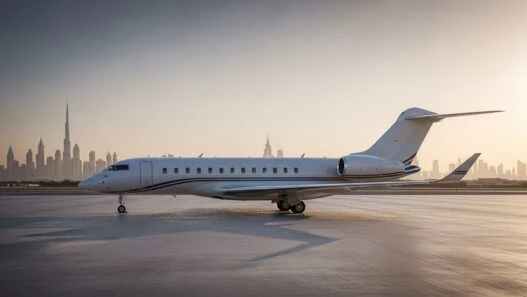The scene unfolds daily across the world’s most exclusive airports: a Fortune 500 CEO boards a Bombardier Global 7500 bound for Dubai, while simultaneously reviewing residency applications for Singapore’s Global Investor Programme. This is not coincidence—it’s the new reality of global mobility trends 2025.
In today’s hyper-connected economy, true wealth is no longer measured solely by static assets or traditional luxury goods. Instead, the ultimate status symbol has become something far more sophisticated: the freedom to move seamlessly across borders, jurisdictions, and economic systems.
According to Knight Frank’s 2025 Wealth Report, over 72% of new ultra-high net worth individuals (UHNWIs) now maintain multi-country residency options—a staggering 28% increase from 2023. This shift represents more than lifestyle preference; it reflects a fundamental transformation in how global mobility trends 2025 are reshaping wealth strategy.
Table of Contents
- The Mobility Revolution: Why Movement Defines Modern Wealth
- Golden Visas: The $50 Billion Legal Pathway to Global Freedom
- ESG Aviation Rules: How ISO 14083 Is Reshaping Private Jet Travel
- Sustainable Luxury: The New Private Jet Travel Standards
- Wealth Migration Patterns: Where Ultra-High Net Worth Individuals Are Moving
- The Future of Elite Mobility: Performance as Identity
The Mobility Revolution: Why Movement Defines Modern Wealth
The drivers behind this mobility revolution are multifaceted and represent a fundamental shift in how wealthy individuals approach risk management and opportunity optimization.
Economic Diversification: Wealthy individuals recognize that geographic concentration creates vulnerability. By establishing legal presence across multiple jurisdictions, they can optimize tax efficiency while maintaining access to diverse investment opportunities. This strategy has become particularly relevant as governments worldwide implement new tax policies targeting high-net-worth individuals.
Political Risk Management: Global political instability has accelerated demand for “Plan B” options. The ability to relocate quickly has become a form of insurance against regulatory changes, political upheaval, or economic downturns. Recent events in various countries have demonstrated the value of maintaining multiple residency options.
Digital Nomad Evolution: Advanced technology enables business operations from anywhere. This freedom has extended beyond startups to include traditional industries, making location independence increasingly practical for substantial enterprises. The COVID-19 pandemic accelerated this trend, proving that many business functions can be performed remotely without compromising effectiveness.
Henley & Partners’ Global Mobility Report 2024 reveals that investment migration programs processed record applications in 2024, with total global investment exceeding $21.4 billion. This represents a 31% increase from the previous year, indicating accelerating momentum in the global mobility trends 2025 landscape.
The implications extend beyond individual wealth management. Countries are increasingly competing for mobile wealth through attractive residency programs, favorable tax regimes, and high-quality infrastructure. This competition benefits investors by creating more options and better terms across multiple jurisdictions.

For investors seeking to understand these wealth migration patterns, the data reveals clear opportunities in jurisdictions positioning themselves as mobility hubs.
Golden Visas: The $50 Billion Legal Pathway to Global Freedom
Golden visa programs have emerged as the most accessible route to achieving global mobility trends 2025 objectives. These residency-by-investment schemes offer wealthy individuals legal pathways to establish presence in strategically important jurisdictions while contributing to local economies.
The numbers are compelling and demonstrate the growing importance of these programs. Investment Migration Insider data shows that UAE Golden Visa applications increased 47% in 2024, while Portugal’s programme attracted €2.1 billion in investment before its recent modifications. Greece processed over 12,000 applications in 2024, generating €3.2 billion in direct investment.
Top Golden Visa Destinations 2025
United Arab Emirates: The UAE Golden Visa offers 10-year renewable residency for investors contributing AED 2 million ($544,000) in real estate or business investment. The programme’s appeal lies in zero personal income tax, strategic location between Europe and Asia, and world-class infrastructure. Dubai has become particularly attractive, adding 68,000 millionaires in 2024 alone.
Greece: Despite recent changes increasing minimum investments in Athens and Thessaloniki to €800,000, Greece’s Golden Visa remains attractive at €250,000 minimum investment in other regions. The programme provides EU access and has generated over €3.2 billion since inception, making it one of Europe’s most successful investment migration programs.
Singapore: The Global Investor Programme requires S$2.5 million ($1.85 million) investment but offers access to one of Asia’s most stable financial centres and highest quality of life indices. Singapore added 3,400 millionaires in 2024, maintaining its position as Asia’s premier wealth management centre.
Malta: The Malta Permanent Residence Programme requires €300,000 government contribution plus property and charity donations. Malta offers EU citizenship pathways and has become increasingly popular among entrepreneurs and digital nomads seeking European access.
OECD mobility data indicates that high-net-worth individuals increasingly view residency as an asset class. This perspective transforms citizenship from cultural identity to strategic portfolio component, enabling sophisticated tax planning and risk management strategies.
The strategic value extends beyond immediate benefits. Golden visa holders gain access to tax optimization opportunities that can significantly reduce global tax burden while maintaining full legal compliance. Multiple residency options enable sophisticated tax planning structures that take advantage of different jurisdictions’ favorable policies.
Business expansion access becomes significantly easier with residency in key jurisdictions, facilitating market entry, banking relationships, and regulatory compliance for international business operations. Many successful entrepreneurs leverage multiple residencies to access different markets and investor networks.
Family security represents another crucial advantage, as many programmes extend benefits to family members, providing education opportunities and security for subsequent generations. This long-term perspective makes golden visa investments particularly attractive to wealthy families planning multi-generational wealth strategies.
Understanding the complete UAE Golden Visa guide becomes essential for investors seeking Middle East access, while European residency programs offer different strategic advantages.
ESG Aviation Rules: How ISO 14083 Is Reshaping Private Jet Travel
Environmental, Social, and Governance (ESG) considerations have fundamentally altered how global mobility trends 2025 intersect with private aviation. The implementation of ISO 14083:2023 has created new transparency requirements that affect how ultra-wealthy individuals approach jet travel and how the industry positions itself.
ISO 14083 establishes standardized methodologies for quantifying greenhouse gas emissions across transport chains. For private aviation, this means operators must now provide detailed carbon footprint data for every flight, creating unprecedented transparency in an industry that previously operated with limited environmental oversight.
The Environmental Impact Reality
According to IATA’s Sustainability Report 2024, private aviation accounts for approximately 2% of global aviation emissions but represents the highest per-passenger carbon footprint of any transport mode. This disparity has created both challenges and opportunities for the industry.
A typical intercontinental private jet flight generates 10-20 times more CO2 per passenger than commercial first-class travel. For a New York to London flight on a heavy jet, the environmental impact comparison is stark: private jet generates approximately 11.2 tonnes CO2 per passenger, while commercial first class produces roughly 2.6 tonnes CO2 per passenger.
These statistics have prompted significant changes in how private aviation markets itself and how clients justify usage. The industry has responded with comprehensive sustainability initiatives that address both regulatory requirements and client expectations.
Industry Response and Innovation
Leading private aviation companies are responding with innovative approaches that maintain luxury while addressing environmental concerns.
Sustainable Aviation Fuel (SAF) Initiatives: NetJets announced a $100 million SAF investment programme, aiming to reduce lifecycle emissions by up to 80% compared to conventional jet fuel. Other major operators have followed with similar commitments, creating a competitive advantage for sustainability-focused providers.
Carbon Offset Programmes: Many operators now offer mandatory carbon offset options, investing in verified environmental projects to neutralize flight emissions. These programs often include reforestation, renewable energy, and carbon capture technologies.
Fleet Modernization: Newer aircraft like the Bombardier Global 7500 and Gulfstream G700 offer significantly improved fuel efficiency compared to older models. Some operators are retiring older, less efficient aircraft ahead of schedule to improve overall fleet environmental performance.
Ernst & Young’s Aviation ESG Brief 2025 indicates that ESG-compliant private aviation is becoming a competitive differentiator rather than regulatory burden, with clients increasingly willing to pay premiums for sustainable options.
Sustainable Luxury: The New Private Jet Travel Standards
Global mobility trends 2025 have given rise to “sustainable luxury”—a paradigm where environmental responsibility enhances rather than diminishes status appeal. This shift represents a fundamental evolution in how wealthy individuals approach private aviation and luxury consumption generally.
The Silent Luxury Movement
Today’s ultra-wealthy increasingly prefer understated demonstrations of status that align with social responsibility. This “silent luxury” approach extends to aviation choices, where sustainability credentials become part of the prestige narrative rather than a compromise.
Leading charter companies are repositioning their services accordingly, recognizing that modern luxury consumers seek experiences that align with their values while maintaining exceptional quality and convenience.
Vista Global has committed to achieving net-zero emissions by 2050, investing heavily in SAF procurement and next-generation aircraft technology. The company positions environmental responsibility as a luxury feature rather than a limitation.
Flexjet offers guaranteed SAF availability across its network, allowing clients to maintain environmental standards regardless of route. This consistency has become a significant competitive advantage in attracting environmentally conscious clients.
Air Charter Service has developed ESG reporting tools that provide clients with detailed environmental impact assessments for each flight. These reports help clients understand and communicate their environmental efforts to stakeholders.
Bloomberg Wealth’s analysis suggests that ESG-compliant aviation services command premium pricing, indicating that sustainability enhances rather than compromises luxury positioning. Clients are willing to pay more for services that align with their environmental values.
Technology and Innovation
Advanced booking platforms now incorporate environmental impact calculations alongside traditional metrics like flight time and cost. Clients can optimize routes for minimal environmental impact while maintaining schedule efficiency, creating a new dimension of luxury travel planning.
Real-time emissions tracking enables dynamic carbon offset purchasing, allowing travelers to maintain carbon neutrality across all flights automatically. This technology integration makes sustainable choices convenient rather than burdensome.
The reputation factor has become crucial for public figures and corporate executives, as sustainable aviation choices serve as reputation management tools. Robb Report’s 2024 luxury survey found that 63% of respondents consider environmental impact when making high-end travel decisions.

For those interested in ESG-compliant private aviation, understanding sustainable aviation fuel options becomes crucial for maintaining environmental standards.
Wealth Migration Patterns: Where Ultra-High Net Worth Individuals Are Moving
Global mobility trends 2025 reveal unprecedented wealth migration patterns as UHNWIs relocate to optimize taxation, lifestyle, and business opportunities. Understanding these flows provides insight into the evolving geography of global wealth and the factors driving location decisions.
Primary Migration Routes
From the United States: High-net-worth Americans are establishing residency in Puerto Rico (Act 60 tax incentives), Portugal (Golden Visa), and Dubai (zero personal income tax). Henley & Partners data shows 10,800 millionaires left the US in 2024, driven primarily by tax optimization and political concerns.
From the United Kingdom: Brexit continues driving UK wealth migration, with 9,500 millionaires departing in 2024. Primary destinations include Dubai, Singapore, and Switzerland, reflecting preferences for political stability and favorable tax environments.
From China: Despite travel restrictions, Chinese UHNWIs continue seeking international diversification. Singapore, Canada, and Australia remain preferred destinations for those able to relocate, driven by education opportunities and investment diversification.
From France: High French taxes have prompted significant outflows, with 8,200 millionaires leaving in 2024. Switzerland, Monaco, and Belgium are primary destinations, offering proximity to France with more favorable tax treatment.
Emerging Destinations
Dubai, UAE: Has become the fastest-growing millionaire destination globally, attracting 68,000 high-net-worth individuals in 2024. The combination of zero personal income tax, strategic location, and luxury infrastructure creates compelling appeal. Dubai’s position as a global business hub has been reinforced by its handling of the pandemic and continued infrastructure investment.
Singapore: Added 3,400 millionaires in 2024, maintaining its position as Asia’s premier wealth management centre. Political stability and business-friendly regulations continue attracting global talent, while the city-state’s strategic location provides access to growing Asian markets.
Portugal: Despite Golden Visa modifications, Portugal attracted 2,800 millionaires in 2024, drawn by EU access, favorable tax regimes, and quality of life. The country’s Non-Habitual Resident program continues attracting retirees and digital nomads.
Switzerland: Remains a traditional favorite, gaining 1,500 millionaires in 2024. Banking privacy, political stability, and favorable tax treaties maintain appeal despite higher costs. Switzerland’s reputation for discretion and financial expertise continues attracting international wealth.
Knight Frank’s wealth migration analysis indicates that tax optimization drives approximately 40% of relocation decisions, while lifestyle factors account for 35%, and business opportunities 25%. This data suggests that financial considerations remain primary, but quality of life factors are increasingly important.
Supporting Infrastructure
Wealth migration requires sophisticated support ecosystems that facilitate seamless transitions across jurisdictions.
Private Banking: Leading institutions like UBS, Credit Suisse, and JPMorgan Chase have expanded international presence to serve mobile clients across multiple jurisdictions. These banks provide coordinated services that simplify complex multi-jurisdictional financial management.
Legal Services: International law firms specializing in cross-border taxation and residency planning have experienced unprecedented demand. These firms coordinate with local practitioners to ensure compliance across multiple jurisdictions.
Concierge Services: Luxury lifestyle management companies facilitate seamless transitions, handling everything from property acquisition to school enrollment. These services remove friction from relocation decisions, making global mobility more practical.
Wealthy individuals considering relocation should explore tax-optimized residency strategies and understand international banking requirements for seamless transitions.
The Future of Elite Mobility: Performance as Identity
As global mobility trends 2025 continue evolving, mobility itself is becoming the ultimate expression of economic sovereignty. The ability to move freely across borders, jurisdictions, and economic systems represents the highest form of financial independence and strategic flexibility.
The Network Effect
Modern wealth is increasingly about access rather than ownership. The most successful individuals in 2025 are those who can access optimal opportunities regardless of geographic location. This requires sophisticated understanding of regulatory frameworks, cultural dynamics, and business practices across multiple jurisdictions.
Regulatory Arbitrage: Understanding and exploiting differences in tax, regulatory, and business environments across jurisdictions has become a core competency for global wealth management. This knowledge enables optimization of business structures and personal finances.
Cultural Fluency: Ability to operate effectively in diverse cultural and business contexts provides competitive advantages in global markets. This skill becomes increasingly valuable as business becomes more international.
Infrastructure Access: Maintaining relationships and resources across multiple geographic regions enables rapid response to opportunities and challenges. This network effect multiplies the value of global mobility.
Technology Integration
Emerging technologies are further enabling elite mobility and creating new possibilities for globally mobile lifestyles.
Digital Identity Systems: Blockchain-based identity verification enables seamless border crossings and regulatory compliance across multiple jurisdictions. These systems reduce friction in international travel and business operations.
AI-Powered Optimization: Advanced algorithms help optimize travel routes, visa requirements, and tax implications for complex multi-jurisdictional lifestyles. These tools make global mobility more efficient and cost-effective.
Virtual Presence: High-quality telepresence technology reduces the need for physical travel while maintaining business effectiveness. This capability enhances the value of strategic travel by reducing routine travel requirements.
The New Status Hierarchy
Traditional status symbols—luxury cars, watches, properties—are being replaced by mobility metrics that reflect true global influence and capability.
Passport Power: Number of visa-free destinations accessible reflects diplomatic relationships and global standing of chosen citizenship countries.
Residency Portfolio: Quality and quantity of legal residency options demonstrate strategic planning and risk management sophistication.
Flight Hours: Access to private aviation for optimal time utilization represents efficiency and global reach capability.
Network Reach: Ability to operate effectively across multiple time zones and cultures indicates global business sophistication.
Forbes Global Wealth Report suggests that by 2030, the wealthiest individuals will be defined not by net worth alone, but by their “mobility quotient”—a composite measure of geographic, regulatory, and economic freedom.
Investment Implications
For investors, global mobility trends 2025 create new opportunities across multiple sectors and geographies.
Infrastructure Investments: Airports, private terminals, and aviation services in key mobility hubs represent growth opportunities as demand for global travel increases.
Technology Solutions: Companies enabling seamless cross-border operations, from digital identity to tax optimization software, address growing market needs.
Real Estate: Premium properties in golden visa destinations and wealth migration hotspots benefit from increased demand from globally mobile individuals.
Financial Services: Platforms serving globally mobile high-net-worth clients represent significant growth opportunities as traditional banks struggle to serve multi-jurisdictional clients effectively.
Smart investors are exploring private jet ownership vs charter analysis while considering wealth management for global nomads strategies.
Conclusion: The Mobility Paradigm
Global mobility trends 2025 represent more than lifestyle evolution—they signal a fundamental shift in how wealth creates and maintains competitive advantage. In an increasingly connected yet fragmented world, the ability to move seamlessly across borders, systems, and opportunities has become the ultimate differentiator.
The convergence of golden visa programs, sustainable aviation standards, and advanced technology creates unprecedented opportunities for those who can navigate this complex landscape. Success in this environment requires not just financial resources, but sophisticated understanding of regulatory frameworks, cultural dynamics, and technological capabilities.
As one prominent family office manager recently observed: “The new passport is your portfolio—and the new runway, your network.”
For investors and entrepreneurs, the implications are clear: mobility is no longer a luxury—it’s a necessity. Those who master the art of global movement will define the next generation of global wealth creation. The future belongs to those who can be everywhere, and nowhere, at once.
The wealthy individuals who thrive in this new paradigm will be those who view global mobility trends 2025 not as constraints or complications, but as opportunities to optimize their lives, businesses, and legacies across the world’s most favorable jurisdictions and markets.




















